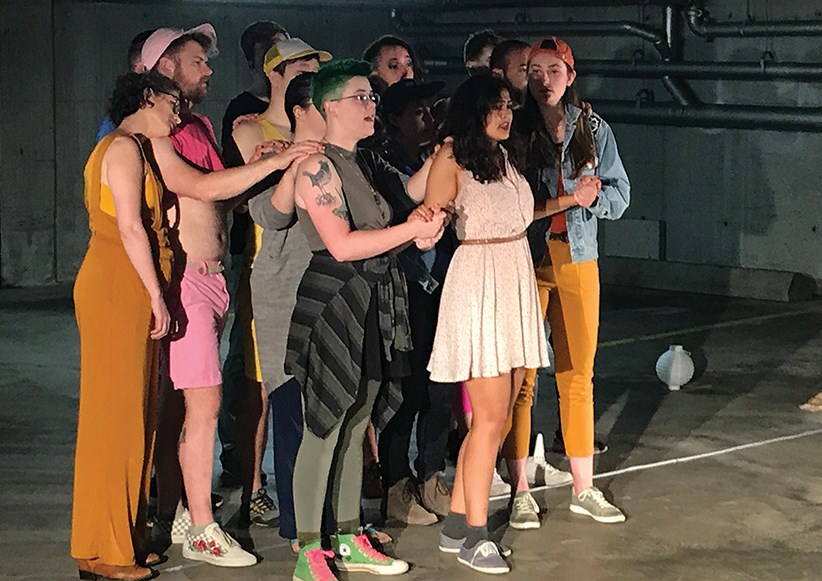Where the Quiet Queers Are, Amplify Choral Theatre at the �鶹��ýӳ��Fringe Festival, Old Bridge Indoor Parkade, Granville Island, Sept. 13 and 14. Sold out. .
We’re here. We’re quiet. Get used to it.
On the lowest level of the Old Bridge Street parkade on Granville Island, a team of singers, poets and producers lug lanterns, lights and chairs past parking spots to their improvised, underground stage.
The parking lot is an ideal setting to suggest long commutes and burnout, as well as a lack of queer gathering spaces, explains Elyse Kantonen, musical director for Where the Quiet Queers Are.
“It’s also a commentary on where we allocate space in the city and how much space is given to cars,” notes the Argyle Secondary grad.
The Fringe Festival show, scheduled to close this weekend, is a mix of choral music, movement and poetry woven into a story about two queer friends surviving high rents and messy relationships in Vancouver.
In movies and plays, a story focusing on queer friendship is a rarity, Kantonen says.
“When you speak about LGBTQ issues . . . people immediately think about sexuality.”
That association has been around for a long time. In his 1981 book The Celluloid Closet, author Vito Russo wrote: “It is an old stereotype, that homosexuality has to do only with sex while heterosexuality is multifaceted and embraces love and romance.”
While sexuality is important, Kantonen clarifies, Where the Quiet Queers Are is an effort to show those underrepresented facets of queer identities that “revolve around community,” she says.
The show is largely about the difficulty of finding friends, the kind of friends that become family, particularly in an expensive, transient city.
“We’re also exploring in the story the ways that being overworked and being burned out have an effect on our personal relationships,” Kantonen says.
The concept seemed to resonate, as a crowdfunding campaign for the show raised $2,915 – exceeding the original goal by $415.
The story of friendship, conflict and reconciliation first came to Kantonen from friend Sara Jellicoe.
Kantonen, who took musical therapy at Capilano University and is now studying conducting and music education at UBC, was instantly intrigued.
“It’s not so much musical theatre, nor is it opera. It’s taking existing choral music and weaving it together with a narrative arc,” she explains.
Kantonen set to finding music by queer composers to create the soundscape.
And as poet Laura Fukumoto crafted dialogue for the show, Kantonen came across “i wanna cry with u” by Michael Park.
The haunting music blended perfectly with the story they were telling and the words that needed to be said, according to Kantonen.
“We were able to either shorten or lengthen the sections of music to have the text spoken over top of it.”
The ethereal piece also seems ideal for the setting.
Besides the symbolism of the parking garage, the setting also lengthens reverberations, allows the audience to hear softer tones and offers dynamics you might not get in a black box theatre, Kantonen explains.
“It’s really doing great things for the music.”
Kantonen was also charged with writing musical transitions between songs.
The show’s characters speak in poetry, with one friend asking: “Am I broken, or refracting? If I hold myself up to the light, what will I see?”
Orchestrated by queer women and with a cast of LGBTQ+ artists, the show is an attempt at creating theatre with a decentralized government.
Everyone in the show had a hand in creating the show, Kantonen says, explaining there is no single director who decides what’s in and what’s out.
“It’s really a project just made by us,” she says.
Besides Kantonen, Jellicoe, and Fukumoto, contributions to the show were also made by producer CR Packer and choreographer Isabella Halladay.
The 45-minute performance piece debuted earlier this month.
It was a special experience for Kantonen. Generally, a choral conductor is permitted to ignore the audience. But for Where the Quiet Queers Are, Kantonen has been conducting from the audience, standing toward the back of the centre aisle as she coaches the show’s 15 singers.
She can see smiles and hear crying.
The show is meant to connect on a “real level with people,” Kantonen says, noting the show is based on many queer experiences.
Asked why a reluctant theatregoer should give the show a chance, Kantonen offers three words: “It’s very human.”


